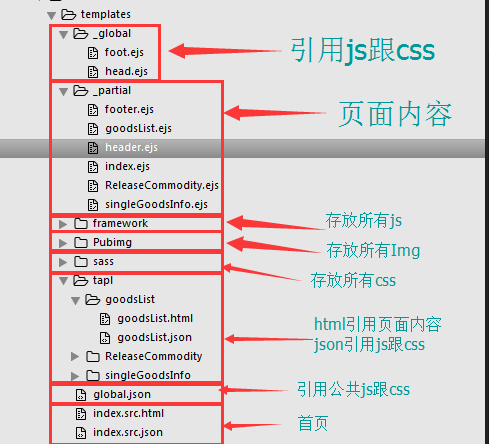在gulpfile.js里添加var ejs =
gulp.task('gulp-ejs', function(){
gulp.src(模版目录 + '/**/*.html')
.pipe(data(function (file) {
var filePath = file.path;
// global.json 全局数据,页面中直接通过属性名调用
return Object.assign(JSON.parse(fs.readFileSync(模版目录+ '/global.json')), {
// local: 每个页面对应的数据,页面中通过 local.属性 调用
local: JSON.parse(fs.readFileSync( path.join(path.dirname(filePath), path.basename(filePath, '.html') + '.json')))
})
}))
.pipe(ejs().on('error', function(err) {
gutil.log(err);
this.emit('end');
}))
.pipe(gulp.dest(生成目录));
});
目录结构

1._golobal文件下的head.ejs
<!DOCTYPE html>
<html>
<head>
<meta charset="utf-8">
<title><%= local.title %></title>
<meta http-equiv="X-UA-Compatible" content="IE=edge">
<meta name="renderer" content="webkit">
<link rel="shortcut icon" href="网站图标路径"/>
<% styles.forEach(function(sty){ %>
<link rel="stylesheet" href="<%= sty %>">
<% }) %>
上面引用公用css下面引用单独页面css样式
<%
if(local.styles) {
local.styles.forEach(function(sty){ %>
<link rel="stylesheet" href="<%= sty %>">
<% })
}
%>
</head>
2._golobal文件下的foot.ejs
<% scripts.forEach(function(js){ %>
<script src="<%= js %>"></script>
<% }) %>
上面引用公用js下面引用单独页面js样式
<%
if(local.scripts) {
local.scripts.forEach(function(js){ %>
<script src="<%= js %>"></script>
<% })
}
%>
3.global.json公用js跟css
{
"_ImgUrl":"页面公用图片路径",
"styles": [
"/PubCss/base.min.css"
],
"scripts": [
"/framework/common/jquery-1.9.1.min.js"
]
}
4.goodsList文件下goodsList.html
<%- include('../../_global/head') %> (引用css)
<body>
<%- include('../../_partial/header') %>(引用公共头部)
<%- include('../../_partial/goodsList') %>(引用单独页面内容)
<%- include('../../_partial/footer') %>(引用公共页尾)
<%- include('../../_global/foot') %>(引用js)
</body>
</html>
4.goodsList文件下goodsList.json
{
"title": "个人中心",
"styles": [
"个人中心css样式"
],
"scripts": [
"个人中心js样式"
]
}